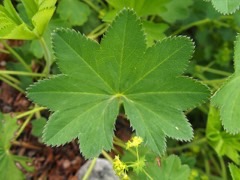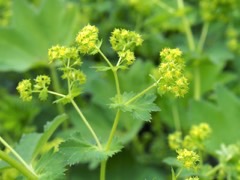 |
|
Agnieszka Kwiecien, Nova wikimedia.org |
 |
| Agnieszka Kwiecien, Nova wikimedia.org |
Translate this page:
Summary
Physical Characteristics

 Alchemilla mollis is a deciduous Perennial growing to 0.6 m (2ft) by 0.8 m (2ft 6in) at a medium rate.
Alchemilla mollis is a deciduous Perennial growing to 0.6 m (2ft) by 0.8 m (2ft 6in) at a medium rate.
See above for USDA hardiness. It is hardy to UK zone 4. The plant is self-fertile.
Suitable for: light (sandy), medium (loamy) and heavy (clay) soils, prefers well-drained soil and can grow in heavy clay soil. Suitable pH: mildly acid, neutral and basic (mildly alkaline) soils. It can grow in full shade (deep woodland) semi-shade (light woodland) or no shade. It prefers moist soil. It cannot tolerate atmospheric pollution.
UK Hardiness Map
US Hardiness Map
Synonyms
A. acutiloba Steven. A. hort. Alchemilla major auct. A. montana Schur. A. vulgaris subsp. acutiloba (Steven) Nyman.
Plant Habitats
Edible Uses
References More on Edible Uses
Medicinal Uses
Plants For A Future can not take any responsibility for any adverse effects from the use of plants. Always seek advice from a professional before using a plant medicinally.
None Known. Although widely planted in herb gardens A. Mollis has no medicinal properties. The species Alchemilla xanthochlora and Alchemilla alpina are recommended.
References More on Medicinal Uses
The Bookshop: Edible Plant Books
Our Latest books on Perennial Plants For Food Forests and Permaculture Gardens in paperback or digital formats.

Edible Tropical Plants
Food Forest Plants for Hotter Conditions: 250+ Plants For Tropical Food Forests & Permaculture Gardens.
More

Edible Temperate Plants
Plants for Your Food Forest: 500 Plants for Temperate Food Forests & Permaculture Gardens.
More

More Books
PFAF have eight books available in paperback and digital formats. Browse the shop for more information.
Shop Now
Other Uses
A good ground cover plant. Grow as ground cover in shade or or beneath open shrubs and trees. Will self-seed into gravel or cracks between paving. Great at the front of borders, as edging for paths or massed as a ground cover. A clump-forming perennial forming dense, leafy mounds of light green leaves.
Special Uses
References More on Other Uses
Cultivation details
An low growing herbaceous perennial plant making an excellent ground cover that grows in a clumping manner. Moist but well-drained soil in sun to partial shade. Sun exposure: Full sun, dappled shade, partial shade. Shade type: Damp. Hardiness: Hardy. Soil type: Well drained,blight, sandy, clay, heavy, moist. Soil pH:5.5 to 7.5. Hardiness Zones:3 to 8. The plant tolerates close to full shade. The Royal Horticultural Society has given it its prestigious Award of Garden Merit (AGM). Dies down completely in winter.
References Carbon Farming Information and Carbon Sequestration Information
Temperature Converter
Type a value in the Celsius field to convert the value to Fahrenheit:
Fahrenheit:
The PFAF Bookshop
Plants For A Future have a number of books available in paperback and digital form. Book titles include Edible Plants, Edible Perennials, Edible Trees,Edible Shrubs, Woodland Gardening, and Temperate Food Forest Plants. Our new book is Food Forest Plants For Hotter Conditions (Tropical and Sub-Tropical).
Shop Now
Plant Propagation
Seed - sow spring in a cold frame. The seed usually germinates in 3 - 4 weeks at 16c[133]. When large enough to handle, prick the seedlings out into individual pots and grow them on a cold frame for their first winter, planting out in late spring or early summer. Division in spring or autumn. The divisions can be planted out direct into their permanent positions, though we find it best to pot them up and keep them in a sheltered position until they are growing away well.
Other Names
If available other names are mentioned here
Garden lady's-mantle, Lady's-mantle
Native Range
TEMPERATE ASIA: Turkey (north) EUROPE: Ukraine, Romania
Weed Potential
Right plant wrong place. We are currently updating this section.
Please note that a plant may be invasive in one area but may not in your area so it's worth checking.
Self-seeds freely but not usually a problem.
Conservation Status
IUCN Red List of Threatened Plants Status : Not Listed

Growth: S = slow M = medium F = fast. Soil: L = light (sandy) M = medium H = heavy (clay). pH: A = acid N = neutral B = basic (alkaline). Shade: F = full shade S = semi-shade N = no shade. Moisture: D = dry M = Moist We = wet Wa = water.
Now available:
Food Forest Plants for Mediterranean Conditions
350+ Perennial Plants For Mediterranean and Drier Food Forests and Permaculture Gardens.
[Paperback and eBook]
This is the third in Plants For A Future's series of plant guides for food forests tailored to
specific climate zones. Following volumes on temperate and tropical ecosystems, this book focuses
on species suited to Mediterranean conditions—regions with hot, dry summers and cool, wet winters,
often facing the added challenge of climate change.
Read More
Expert comment
Author
(Buser) Rothm.
Botanical References
Links / References
For a list of references used on this page please go here
Readers comment
| Add a comment |
|
If you have important information about this plant that may help other users please add a comment or link below. Only comments or links that are felt to be directly relevant to a plant will be included. If you think a comment/link or information contained on this page is inaccurate or misleading we would welcome your feedback at [email protected]. If you have questions about a plant please use the Forum on this website as we do not have the resources to answer questions ourselves.
* Please note: the comments by website users are not necessarily those held by PFAF and may give misleading or inaccurate information.
To leave a comment please Register or login here All comments need to be approved so will not appear immediately.
|
Subject : Alchemilla mollis
|
|
|
|